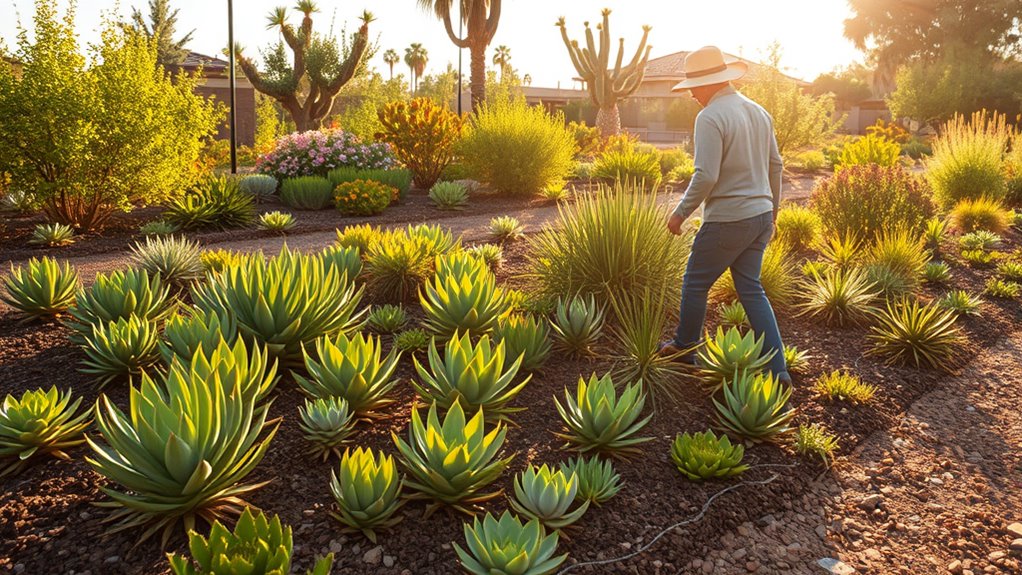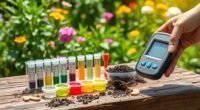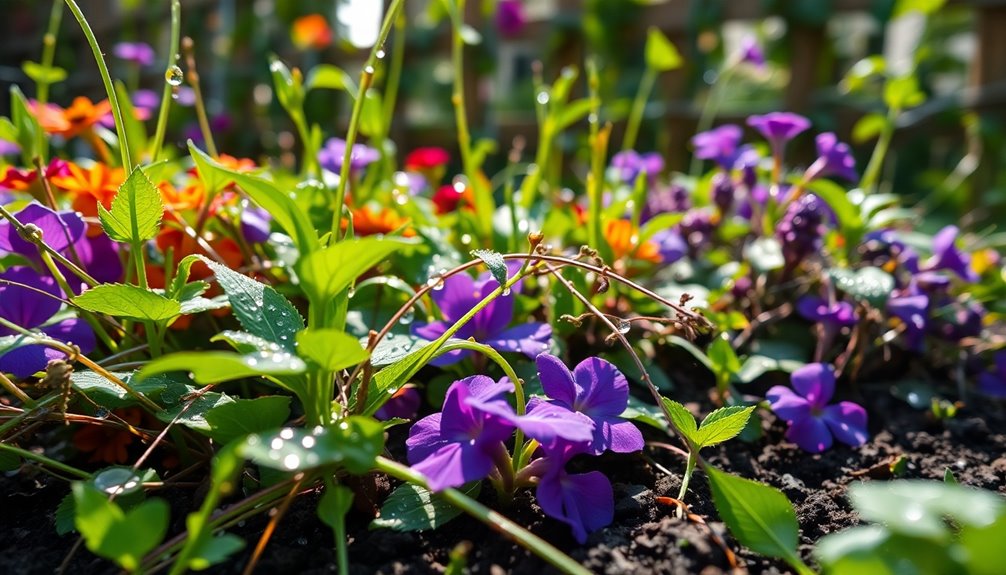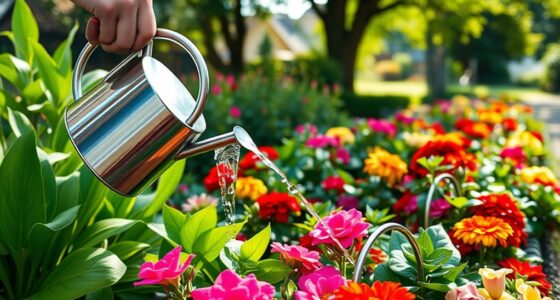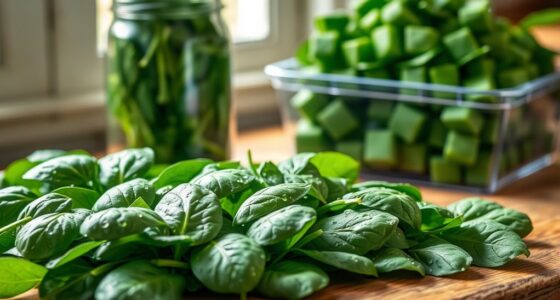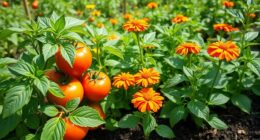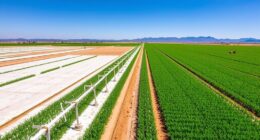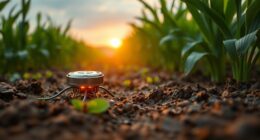To save water while gardening in drought conditions, choose native plants adapted to your area’s climate, requiring less water and maintenance. Use drip irrigation to deliver water directly to roots, reducing evaporation and runoff. Mulch around plants to retain moisture and suppress weeds, while watering early morning or late evening minimizes evaporation. Regularly check your irrigation system for leaks. Following these strategies helps create a resilient, drought-tolerant garden—there’s more to discover for water-wise gardening success.
Key Takeaways
- Use native plants adapted to drought to reduce water needs and support local ecosystems.
- Implement drip irrigation to deliver water directly to plant roots, minimizing evaporation and runoff.
- Mulch around plants to conserve soil moisture, suppress weeds, and regulate soil temperature.
- Water early in the morning or late evening to decrease water loss through evaporation.
- Regularly inspect and maintain irrigation systems to prevent leaks and ensure efficient watering.
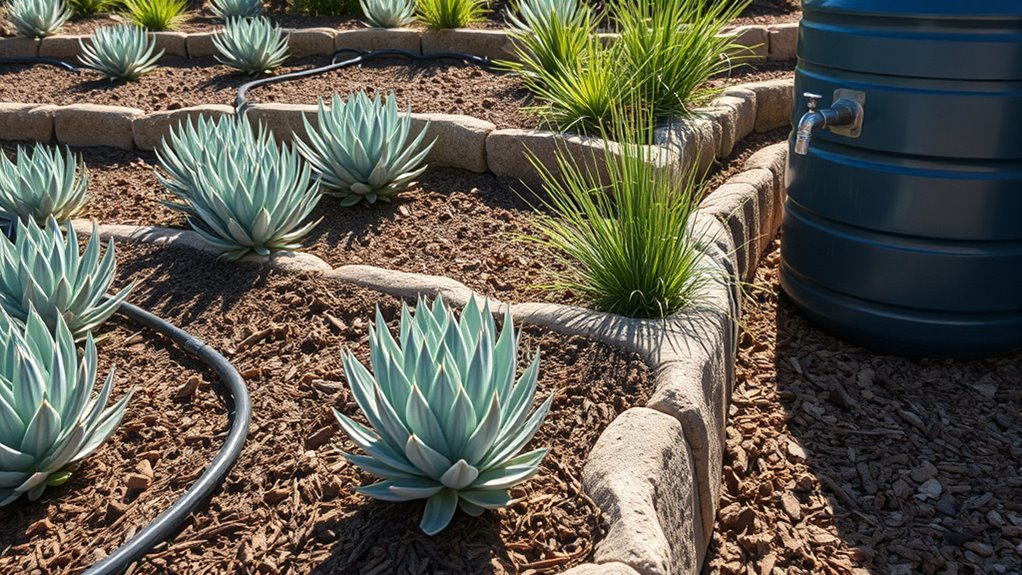
When drought conditions strike, maintaining a healthy garden becomes more challenging, but with the right strategies, you can still thrive. One of the most effective ways to conserve water is by choosing native plants. Native plants are adapted to your local climate and soil, meaning they require less water, fertilizer, and maintenance than exotic species. They’re resilient, drought-tolerant, and often resistant to pests, making them ideal for water-saving gardening. By incorporating native plants into your landscape, you not only reduce your water consumption but also support local ecosystems and biodiversity. These plants typically have deep root systems that access underground moisture, allowing them to survive periods of drought without additional watering.
Choose native plants to conserve water and support local ecosystems during droughts.
Another vital technique involves installing a drip irrigation system. Unlike traditional sprinklers, drip irrigation delivers water directly to the roots of your plants through a network of hoses and emitters. This targeted watering minimizes evaporation and runoff, ensuring that every drop counts. With drip irrigation, you can set a specific schedule, providing consistent moisture without overwatering. It’s especially beneficial for vegetable gardens, flower beds, and container plants, where precise watering can greatly reduce water waste. Automated drip systems also save you time and effort, allowing you to focus on other gardening tasks while maintaining ideal soil moisture levels. Additionally, efficient watering practices like adjusting the system seasonally can further optimize water use.
Combining native plants with drip irrigation creates a powerful duo for water conservation. Native plants thrive with less water, and when paired with efficient watering systems, they require even less supplemental irrigation. This approach helps you establish a sustainable garden that withstands drought conditions while reducing water bills. Additionally, maintaining healthy soil is essential; mulching around plants conserves soil moisture, suppresses weeds, and stabilizes soil temperature. Organic mulches like bark, straw, or composted leaves work well and complement your native plant selection. Furthermore, selecting plants with drought-tolerant roots can enhance your garden’s resilience and reduce watering needs even further.
It’s also wise to water early in the morning or late in the evening when temperatures are cooler, and evaporation rates are lower. This ensures your plants receive maximum hydration with minimal water loss. Regularly check your irrigation system for leaks or clogs to prevent waste and ensure even coverage. Moreover, choosing drought-tolerant plants during garden planning can greatly enhance your garden’s resilience based on plant selection. By integrating native plants, drip irrigation, mulching, and mindful watering practices, you build a resilient garden that survives droughts and conserves precious water resources. With patience and planning, you can create a vibrant, sustainable garden that stays healthy despite the drought challenges.
Frequently Asked Questions
How Can I Improve Soil Moisture Retention Naturally?
To improve soil moisture retention naturally, you should focus on adding organic soil amendments like compost or mulch, which help retain water and improve soil structure. Incorporate effective watering techniques such as deep, infrequent watering to encourage deep root growth. These strategies work together to keep your soil moist longer, reducing water waste and supporting healthier plants, even during drought conditions.
Are There Drought-Resistant Native Plants Suitable for My Area?
Oh, so you want to turn your yard into a desert oasis, huh? Well, smart plant selection is your secret weapon. Look for native species that thrive with less water—they’re already adapted to your area’s climate. These drought-resistant native plants not only save water but also support local ecosystems. Trust me, your garden will flourish with less fuss and more style, even during dry spells.
What Are the Best Times of Day for Watering During a Drought?
The best times of day for watering during a drought are early morning or late evening. This ideal timing minimizes evaporation and ensures your plants get maximum moisture. Stick to a consistent watering schedule, preferably every few days, depending on your soil and plant needs. By watering during these periods, you conserve water and help your garden thrive despite the drought. Proper timing is key to efficient, water-saving gardening.
How Can Mulching Reduce Water Needs in My Garden?
Imagine your garden wrapped in a cozy blanket, shielding the soil from harsh sun and wind. Mulching acts like this blanket, providing soil insulation that keeps moisture in and prevents rapid evaporation. It also suppresses weeds, preventing them from stealing precious water and nutrients. With mulch, your plants stay happier, watering needs decrease, and your garden thrives even during droughts. It’s nature’s way of helping you conserve water effortlessly.
What DIY Irrigation Systems Are Most Efficient for Drought Conditions?
You can create efficient DIY irrigation systems using drip irrigation or soaker hoses. Drip systems deliver water directly to plant roots, minimizing waste, while soaker hoses provide even moisture across garden beds. Both options are easy to install and can be tailored to your garden’s layout. By using these systems, you conserve water, reduce evaporation, and guarantee your plants get consistent hydration, especially during drought conditions.
Conclusion
By adopting water-saving gardening techniques, you can thrive even during droughts. Just remember, lawns and gardens account for nearly 40% of household water use, so your efforts make a big difference. Using drought-tolerant plants, mulching, and efficient watering can conserve water and keep your garden healthy. With these simple steps, you not only save water but also contribute to a more sustainable environment, proving that smart gardening is both effective and rewarding.

